Van Life Cooking Tips: How to Meal Plan & Cook in a Small Space
This van life cooking guide shares tips for making easy meals in a camper van including how to plan, save money, and make doing dishes easy.
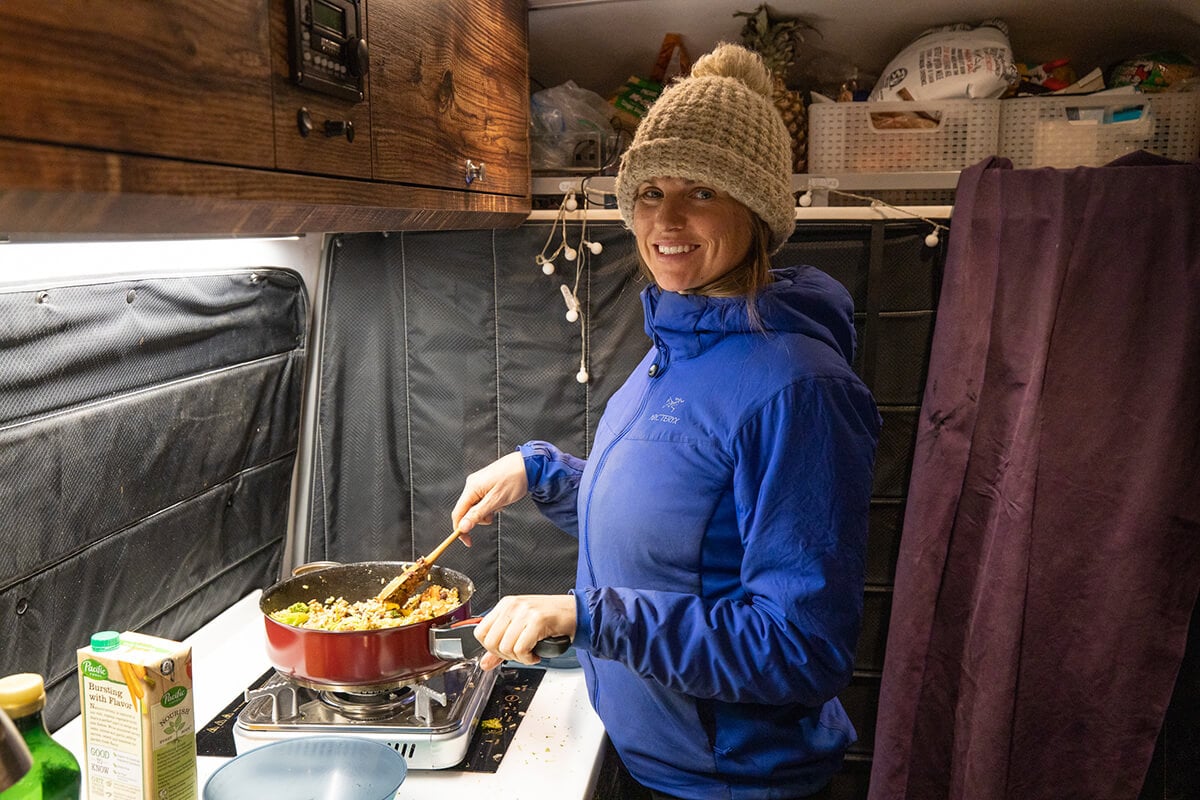
Van life cooking can seem daunting at first – with such a small space, limited access to water, and without the usual conveniences of home (oven, microwave, large fridge, etc.), how can you make easy, healthy meals on the road?
In this guide to van life cooking, we share tips to help you reach van life chef status with advice on grocery shopping and ingredients that make cooking in a small space easier. These tips will help you save time on cooking and cleanup, maximize your water supply, and inspire you to prepare your own healthy meals instead of eating out all the time.
This post may contain affiliate links.
Meal Planning
As you travel, you’ll be shopping at a variety of grocery stores – some will be major chains you’re used to finding at home, but in more rural areas, you might find the grocery stores to be a little bare-boned and expensive. This means that you’ll want to have your pantry stocked with your favorite essentials when you take off and to plan ahead if possible. This is especially helpful if you have any specific dietary needs (ie. gluten-free or plant-based). By planning ahead, you can minimize the amount of time you spend shopping and ensure that you can set out and adventure without having to worry about where the nearest grocery store is.
On the road, we strive to plan our meals for 5-7 days at a time. This isn’t always the case, like when we are closer to a town where there are grocery stores and restaurants readily available, but if we know we are going to be off the grid and away from services, then we try to plan ahead and get everything we need in one fell swoop.
Before you go into the store, you’ll want to decide on a few breakfasts, lunches, and dinners for the week, then make a list of the ingredients you need. If your meals have overlapping ingredients, that will make grocery shopping and storing food in the van even easier.
There are a few things to keep in mind when planning meals and making your grocery lists for van life cooking. One is that the size of your fridge limits how many groceries you can actually store. My 85-liter fridge can fit a week’s worth of groceries with some Tetris, but if your fridge is smaller you may want to shop for 5 days or so at a time.
Next, beverages take up a lot of valuable space in your fridge so you have to decide whether that kombucha or 6-pack of IPA is a higher priority for fridge space than a container of spinach or fresh berries, for example. Of course, you can just keep 1-2 drinks cold at a time and restock as you drink them, but this is something to keep in mind before you go too crazy in the beverage aisle.
Finally, just like at home, some fruits and veggies go bad faster than others (like mushrooms). You’ll want to pay attention to this, eat things that go bad quicker first, and try to buy things that you know will have a longer shelf life in the van.

Save this post!
Enter your email & I'll send this post to your inbox! You'll also receive my weekly newsletter full of helpful advice for planning your adventures.
Easy Van Life Meals & Camper Van Food Essentials
I find that van life cooking is really not all that different than what I cook at home, usually just a simplified, easier version.
Successfully preparing a variety of meals in the van all starts with making sure you have what you need, and just like when you’re at home, it’s always helpful to have the basics handy in the van. You’ll want a variety of spices, sauces, oils, and other staples that make it easier to cook on the fly.
As you plan your meals and make your grocery list, keep in mind that certain items generally take a long time to cook from scratch – items like beans, brown rice, and hearty soups – and these will drain your propane or battery power since they take nearly an hour (or more) to cook.
Download this list of my favorite easy van life meals and pantry staples to have on hand to make grocery shopping easy.

Tips for Cooking Easy Meals
Buying pre-cooked rice and grains is a great shortcut. It’s a common misconception that you need a microwave to “cook” or heat these up, but that’s not true. When we want to cook something with rice, we just dump a microwaveable packet of rice into a pan with some sauce, a little olive oil, or water and let it heat up. Quinoa and couscous are also great options that are quick and easy to cook.
When you’re tired and don’t feel like doing something elaborate, ready-to-go items can speed up the cooking process. Things like veggie burgers, veggie/grain sausages, pre-cooked tofu, and pre-made sauces, like curries, can really speed up the cooking process. I also recommend buying pre-made salad mix, or at a minimum, pre-washed greens which will save you time (as well as water).
Another favorite trick of mine is to use infused olive oils and vinegars when you’re cooking. These add a big burst of flavor to your food and reduce the need for a bunch of different seasonings and spices. Combined with a pre-seasoned spice mix and a little salt and pepper, and you can have food that tastes pretty gourmet.
The final thing I’ll mention is snacks. You’re going to want a rotating variety of snacks you love to keep you fueled throughout the day, whether that be on a long drive or a day outside on the trail. We try to stock up on healthy snacks like fruit, veggies and dip, and healthy bars, although we almost always have some sort of chips in the van too. We wrote a blog post about our favorite hiking snacks, which double as regular snacks in the van.
Grocery shopping all comes down to personal preference, but hopefully these tips get you thinking about how you can take your favorite things to cook and simplify that process so you can continue to eat those meals easily in the van.

Saving Money & Reducing Waste When Grocery Shopping
As I mentioned in our blog post on how much van life costs, food will be one of your biggest expenses on the road.
Here are some tips for saving money when grocery shopping:
Shop on a Budget
Look for more budget-friendly stores like Grocery Outlet and Big Lots. Even when shopping at other grocery stores, you can cut back on your spending by choosing generic brands, avoiding meat and seafood, avoiding prepared foods, and avoiding expensive drinks like kombucha and craft beer.
Plan Ahead
If you plan ahead a little and make a grocery list, it’ll be easier to stick to buying the items you need rather than grabbing anything off the shelf that catches your eye – same goes for not shopping when you’re hungry. This will also help you be more efficient in your purchasing and reduce food waste since you’ll only be buying items that you plan on using.
Buy in Bulk
Bulk bins are a great way to buy only what you need and can often help you save money as well. Take it a step further by bringing in reusable bags to fill from the bulk bins, rather than using new plastic bags each time. For staples that you want to have in the van often, like oats, quinoa, lentils, chia seeds, or nuts for example, you can keep jars or containers for them in your van that you can transfer your bulk bin purchase into.
Don’t forget your reusable bags when you grocery shop too. It’s always handy to have one or two multipurpose reusable bags in the van for a variety of uses, especially ones that pack down small.
We often buy snacks and other staples at Costco instead of the grocery store, and it’s helped us save a good chunk of money. Instead of spending $2-3 on an expensive bar at the grocery store or a box of snacks that I’m not crazy about, I can buy bars, nuts, snacks, and other staples that I love in bulk at Costco. Having a good snack selection in the van also helps prevent impulsive and unhealthy purchases at gas stations. And the good news is you can’t go too crazy at Costco, buying things like you might when you live in a house, because you only have so much room in the van.
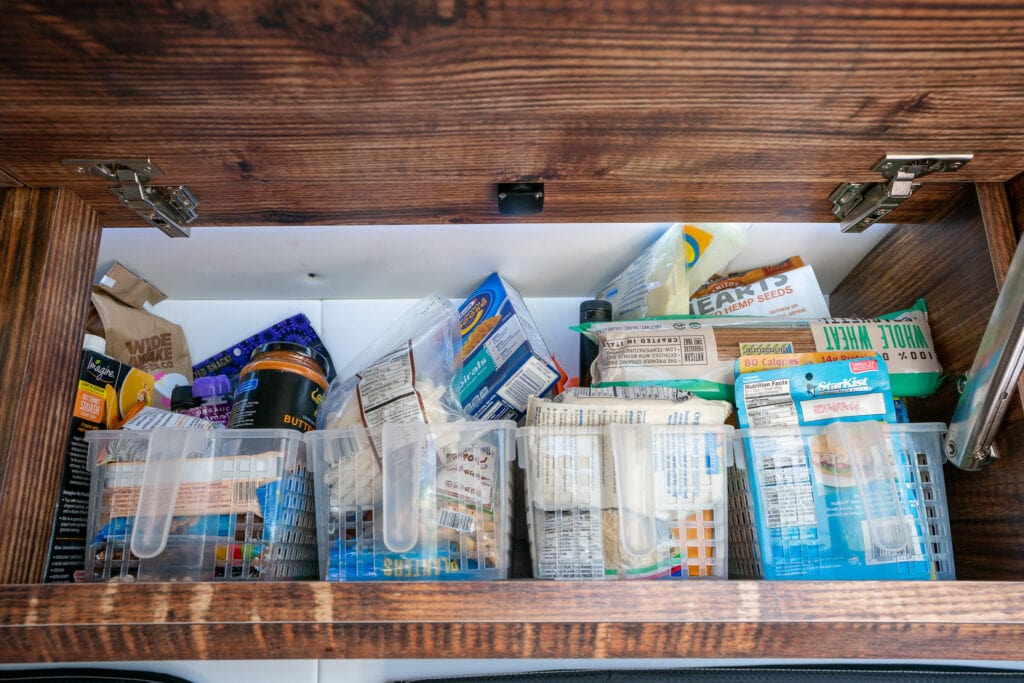
How to Make Cooking in a Small Space Easier
Your van kitchen is smaller and more limited than your kitchen at home, with limited counter space and only one or two burners to work with, and you most likely will not have an oven in your van (although some people do!).
One of the main things we’ve learned from van life cooking is that cooking vegetarian makes things much easier. Dealing with meat and seafood in the van is more work than it’s worth to us, plus we switched to a plant based diet and haven’t looked back since.
Meat and seafood require stricter sanitation – you’ll need to be careful about how you store it in your fridge so it doesn’t contaminate anything else, and after handling it raw you’ll need to be sure to clean everything it touched thoroughly. Also, the fat and oils from cooking meat and seafood tend to get everywhere and make more of a mess in the van, which isn’t ideal considering you’re not only cooking in your kitchen, but this is also where you brush your teeth and wash your face at night.
With a vegetarian diet, there’s none of this, and you can learn to work in other sources of protein like tofu, tempeh, beans, greens, and whole grains. If you do want meat, pre-cooked rotisserie chicken is a good option or you can always save a good steak or some seafood for a night out.
Another key tip is to prep everything before you start cooking. This is something I like to do at home as well as it makes cooking less stressful. Chop up all your veggies, get out your spices, and do any other prep work needed so you have everything ready to go when you turn on your stove.
When it comes to stocking your kitchen with your cooking gear, consider using multi-functional tools, pots, pans, and plateware. For example, you can have one insulated coffee mug that you use for morning coffee and evening cocktails – we love our Stanley cookware. Or you can have a collapsible Tupperware container that can also double as a salad bowl. Thinking multi-purpose will help you save limited space in your galley drawers. Plus, the fewer utensils and dishes you use to cook a meal, the quicker the cleanup will be.
For more tips for getting your van kitchen space ready, check out my most used camp kitchen essentials.
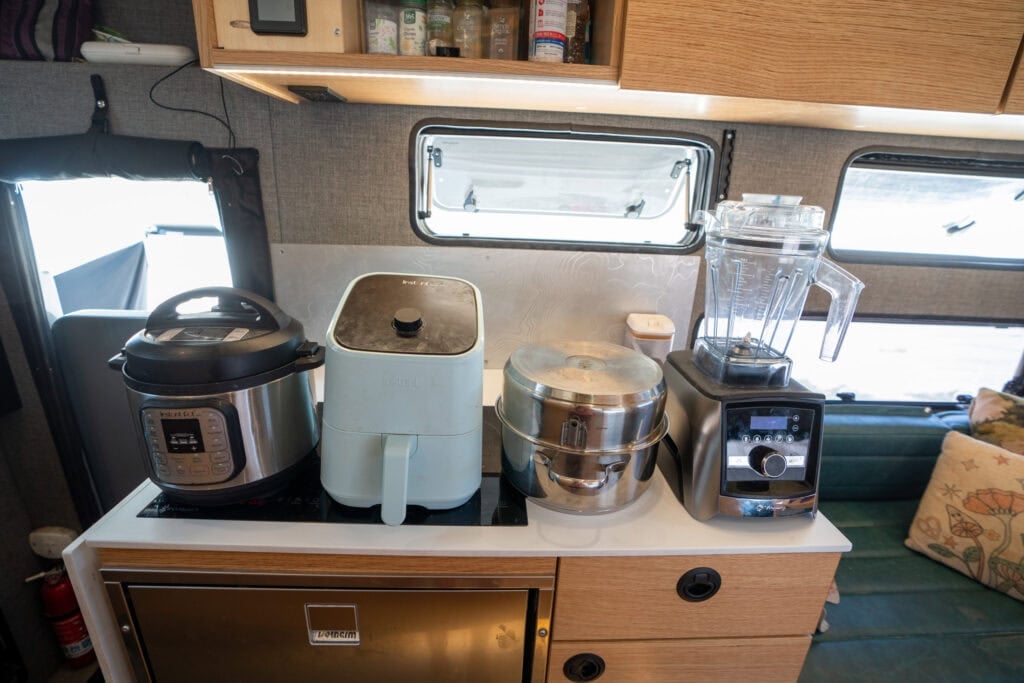
Making Coffee in the Van
There are lots of different options for making coffee in the van, just like there are at home. If you’re a coffee aficionado you likely already have a method you enjoy, so whatever that method is, you can easily adapt it to the van. The key is you want whatever you use to make coffee to be compact so it doesn’t take up a ton of room and is easy to clean. You also want it to be durable so it doesn’t break when you hit a big bump. Finally, and maybe most importantly, your coffee method needs to not consume a lot of power, so a regular plug-in-the-wall drip coffee maker probably won’t work.
While instant coffee is a cinch, if you’re a coffee lover, you’ll likely want to enjoy a real cup in the morning. If you’ve followed me for a while, you’ll know that AeroPress is my coffee maker of choice. It makes a strong cup of coffee, and what I love most about it is that clean-up is a cinch. You literally just plunge the grounds into the trash, rinse, and it’s ready for the next cup. Plus it’s compact, lightweight, durable, and inexpensive.
A french press or pour over set up are two other common and easy methods for making coffee on the road. Glass french presses are easy to break, especially in a small space like a van, so I’d recommend looking for something more durable like a stainless steel one. The other thing to keep in mind when it comes to your water consumption is a french press is going to leave you with a bunch of wet messy coffee grounds that you need to rinse out once you are done making your coffee.

Cleanup & Dishes in a Van
Now that we’ve covered grocery shopping, cooking, and coffee, let’s get to the not-so-fun part of life on the road – clean-up and dishes.
Keeping things simple and easy to clean is key. For one, this means only using the dishes you need when cooking and eating. Do you really need one bowl for soup and one bowl for a salad? Or can you eat the salad first, then use the same bowl for soup? This may seem obvious but you might be surprised by how many dishes you generate at first. After a few days of cooking on the road, you’ll get in the mindset of reusing and keeping things simple so you can reduce the clean-up after dinner. After all, you only have a limited amount of water, and you won’t have the luxury of a dishwasher or a big sink to let dishes pile up in.
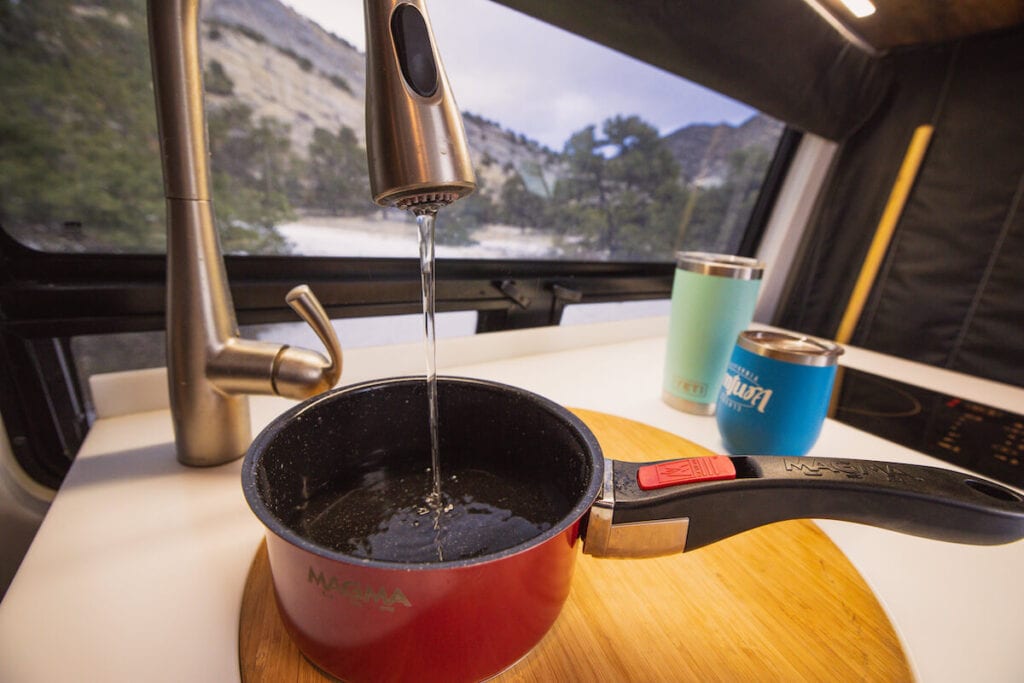
Here are some tips for making kitchen cleanup in the van easy:
Pre-Cleaning Dishes
Soaking or cleaning dishes right away after a meal prevents hard build-up and will require less water for cleaning. But before you start doing dishes, you’ll want to scrape all of the food particles and excess sauce into the trash. If you use a paper towel as a napkin, use that to wipe off your plate as well as possible or you can even lick your plate clean in real van life fashion. This will prevent food particles and all the smells that go along with it from going down your drain. It will also help you save water because your dishes will already be wiped clean. Then you’ll want to make sure you have a strainer in your drain to help catch any remaining particles.
Conserving Water
There are a few ways you can conserve water when doing dishes. One thing that helps is to go easy on the soap. Less soap means you’ll have fewer suds to rinse off, which can help you save water. We personally like to put a little eco-friendly dish soap in a cup with some water on the counter and then we dip our dish brush in there when we need more water or soap.
Another option is to use a spray bottle mixture of Dr. Bronner’s and water to spray down the dishes – this really helps cut down on the amount of suds produced. You can use this same method to rinse dishes – simply fill up a spray bottle with clean water, give your washed dishes a spritz and then wipe them dry.
You’ll also want to be careful to not run the water when you are doing dishes. Get your sponge or dishes a little wet, then turn off the sink. Scrub away, and then turn the water back on for a quick rinse. By using this method, you’ll be surprised how little water you need to do dishes once you get the hang of it. In fact, 1-2 gallons of water can be enough for both washing and rinsing dishes after a meal.
Drying Dishes
For drying dishes, I recommend getting a couple of quick dry towels. These get the job done quickly and will easily air dry in your van. For wiping up messes on the countertop, we use a sponge to help cut down on our paper towel usage. You may look at secondhand shops to find like-new dishtowels or even linens you can cut into hand towels to outfit your van kitchen on a budget, while also reducing your environmental impact.
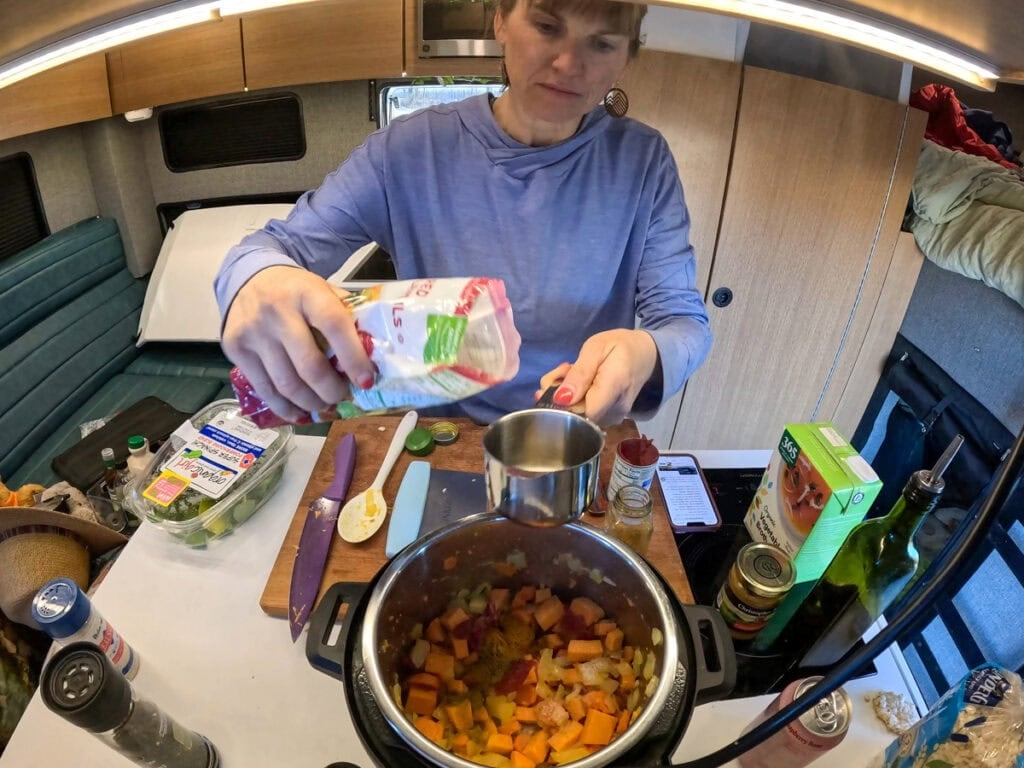
Gray Water Disposal
Gray water tanks collect used dishwater and other liquids that go down the drain. You may or may not have a gray water tank, and in fact, you might not have a sink at all and in that case, you’ll definitely want a collapsible bucket that you can use for doing dishes.
I don’t have a grey water tank in my current van so when it comes time to dispose of the 1-2 gallons of wash water, we collect it in a bucket as it drains from the van, then we make sure we are at least 200 feet from rivers, lakes, or streams and scatter it on barren dirt. Remember, even biodegradable soap is harmful to aquatic life and can pollute waterways, so making sure you are at least 200 feet away from water is very important.

Do you have any tips to share or any questions about van life cooking? What are your favorite meals to cook or your best kitchen hacks for cooking inside a van?

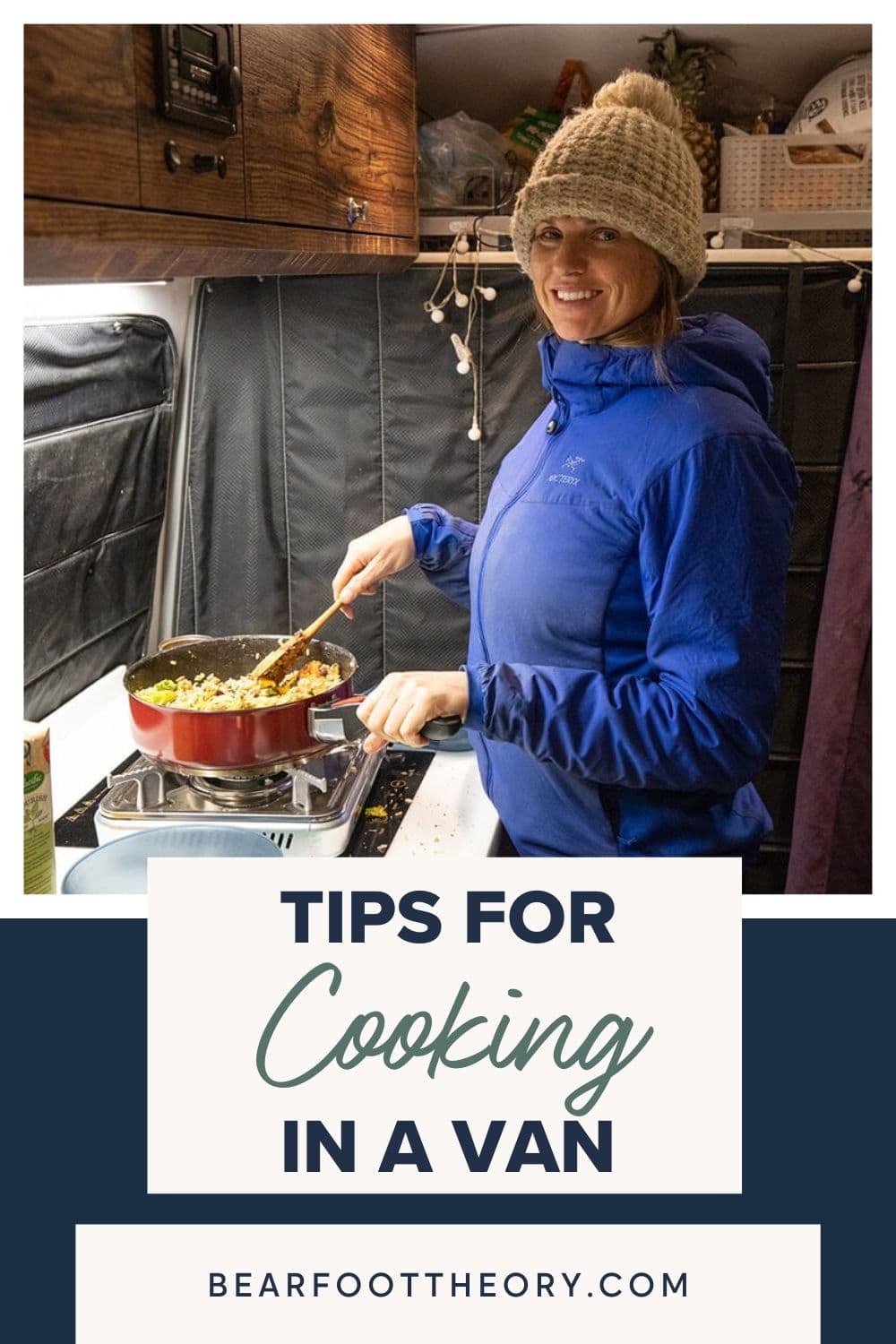
Hey great post Kristen! I have one tip: use a pressure cooker! We use this to cook most of our meals in the van, actually. You can cook a pot of dried beans from scratch in just 30-35 minutes, and hearty soups in 10-15 minutes. Definitely reduces propane usage. We even cooked white rice in the pressure cooker in about 7 minutes. I also use the pressure cooker all the time to make vegetarian Indian food in about 5-7 minutes. We have that and one other pot – a non-stick – in our van. 🙂
Great tip! Do you have a low-wattage pressure cooker?
I use a pressure cooker too! Mine is the old school stove top kind. There is a bit of a learning curve to it. Once you sort out the timing, you’re golden. They take way less propane and you don’t have to stress about another thing taking electricity. Plus! They take up less space than an electric pressure cooker.
Great info, being a beginner at this will save me a lot of grief.
Thanks Sharon!
Ultimately simple & compact coffee gear: a mason jar and a gold (or other metal) filter. Add ground coffee to room-temp water for tomorrow’s cold-brew coffee. Strain into a pot & heat. Refill jar for tomorrow.
Kristen,
We appreciate you sharing your van-life cooking tips and tricks. We’re going to try your clever dishwashing ideas.
We found paper towels keep produce fresher, longer. Roll up a zucchini, wrap 1/2 bell pepper or bunch of cilantro in paper towel. We put washed lettuce in zipped, reusable bag with a couple sheets of paper towels, and squeeze out air.
One of our favorite go-to, one-pot dishes is chicken breast or rotisserie chicken in salsa, with pre-made rice, and broccoli or canned green beans. We simmer the chicken and salsa together in sauce pan. When the chicken’s close to being done we stir in the veggies and rice and heat until warmed through. This could also be made with tofu or other type of plant protein.
Cheers!
Great tip about the paper towels, Kathy. And thanks for sharing your recipe, sounds delish!
I have had 2 RVs and am starting van life in sept, part time at first. I love your roadmap. I am very excited to learn you are plant based! I have been plant based since 1995.
Hi Kristen! First, thanks for the official go-ahead “… or you can even lick your plate clean in real van life fashion”. I’ve been looking for that approval my entire adult life (though to be honest my loving wife doesn’t complain as long as nothing stays on the outside of my face…)
Your suggestion about using a spray bottle to rinse is brilliant. It beats the heck out of my “adjust the faucet to dribble” approach to conserving water.
In our van, Christine is the good cook and loves it, while I’m the constant dish washer after meals. Certainly a fair trade given our respective skill sets.
Our dish-washing strategy: When we need hot water we boil it on the stove. We have a rectangular rubber tub that just fits (and is stored) in the sink. It permits a two basin washing strategy. Dirty dishes in the sink, cleaned (but not yet rinsed) dishes in the rubber tub, then rinsed dishes back in the sink to dry (if not dried with a towel).
My experience for low water consumption dish-washing mirrors yours but has a four step process: 1) boil a cup or two of water in the tea-kettle (to be mixed with another two or three cups of cold water for washing) 2) wipe off all dishes, cutlery and pots and pans to remove any remaining food possible, 3) Mix the hot and cold water into the largest pot used, add soap, and use that to wash all dirty dishes, 4) Rinse using minimal water (this step significantly improved using your spray bottle suggestion). Works like a charm!
The trick to water conservation is to know how much water you are really using. This is not possible by just having the faucet run and the flow going down the drain.
Thanks for those dishwashing tips, Markus!
What toaster oven do you think is best for Van Life traveling?
1-Just a toaster oven?
2-Toaster Oven with convection?
3-Best for saving energy, while having solar and batteries available?
Hi Cheryle, we don’t know many people with traditional toasters in their vans and it really depends on your power setup and how much wattage it pulls. If you simply want to be able to toast bread, one of our team members uses a foldable toaster on her camp stove: https://amzn.to/3IoIxui. You can also “toast” in a regular pan. Good luck!